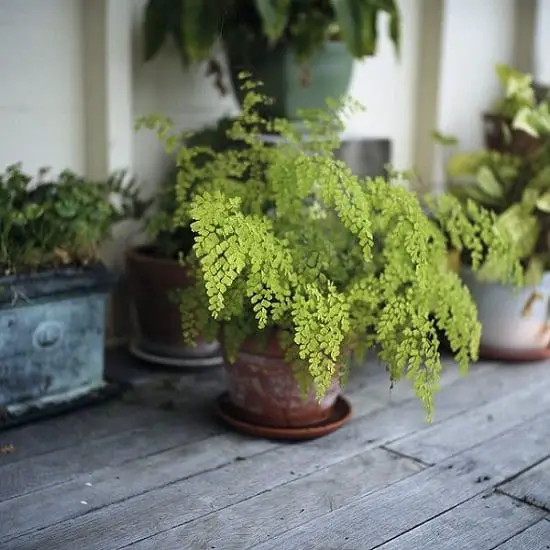Epsom Salt for Ferns can do wonders! It can make your fern plants greener and lusher. How? Find out in this article.
If you want to maintain the lushness and vibrancy of your ferns, you might be surprised to learn that Epsom salt can be a natural and cost-effective solution. In this guide, you can learn how to use Epsom salt for ferns, ensuring they thrive with minimal effort.
Explore Epsom Salt Uses In Garden in this Post
The Benefits of Epsom Salt for Ferns
1. Nutrient Boost
Epsom salt, chemically known as magnesium sulfate, contains essential micronutrients like magnesium. Magnesium is a key component in the photosynthesis process, aiding in the production of chlorophyll.
Applying Epsom salt can give plants an extra nutrient boost, promoting healthy growth.
2. Green Foliage
Magnesium plays a vital role in the development of green pigments in plants. Using Epsom salt contributes to the overall green coloration of your fern’s foliage.
This enhances their aesthetic appeal and indicates a healthier, nutrient-rich plant.
3. Improved Soil Quality
Epsom salt can enhance the structure of the soil by improving drainage. This is crucial for ferns, as they prefer consistently moist soil but can suffer from root rot if it becomes waterlogged.
Adding Epsom salt helps strike a balance, ensuring optimal moisture levels.
Note: You should know that using Epsom salt to enhance soil structure and improve drainage for ferns is a topic of debate. You should consult an expert before using it in excess.
Find Out How to Use Epsom Salt As a Fungicide for Plants
Deficiencies in Ferns that Epsom Salt Can Treat
1. Magnesium Deficiency in Plants
If the leaves of your fern plants are pale or yellow and have slow growth, it may be due to leaf chlorosis — a condition in which plant leaves produce less chlorophyll. One of the possible reasons behind this condition is magnesium deficiency.
Container plants often face this problem as the plants use up all the nutrients in the soil. Low temperatures, acidic soil, and excess potassium or sodium are also a few factors that cause magnesium deficiency.
2. Sulfur Deficiency in Plants
Similarly, a lack of sulfur causes yellowing leaves, particularly between the veins of the leaves. These symptoms occur first in young leaves. Sulfur-deficient plants are small, pale, and lack vigor.
Sulfur deficiency is common in container plants, sandy soils, waterlogged conditions, and acidic soils.
Find Plant Deficiency Symptoms in this Article
How Epsom Salt for Ferns Can Help?
Epsom salt contains 10 percent magnesium and 13 percent sulfur; application of it can increase both of these essential nutrients.
They help in chlorophyll production, healthy plant growth, and resistance against diseases and pests. Both of them are required if you want to grow Lush and Green Ferns.
Note: While Epsom salts provide targeted benefits for ferns, they are not a substitute for an all-round, balanced fertilizer.
Explore Uses of Epsom Salt for Tomatoes in this Article
How to Apply Epsom Salt on Ferns?
- If you see the symptoms mentioned above, add 2 tablespoons of Epsom salt in 1 gallon of water and spray once a month on the foliage when your ferns are growing actively.
- Reduce the quantity to 1 tablespoon per gallon of water when the growth slows.
- The foliar application will make your ferns lush and healthy.
- You can also mix a pinch of Epsom salt in a balanced fertilizer before applying. Or, if you like, administer the dose of 1 tablespoon of Epsom salt around the base of your plants once a month until you see the favorable results.
NOTE: If you’re growing ferns in a cold climate, avoid applying Epsom salt in winter.
Discover How To Make Hostas Grow Bigger with Epsom Salt
Ferns that Benefit From Epsom Salt
- Boston Fern (Nephrolepis exaltata): Epsom salt can contribute to its vibrant green fronds by providing essential magnesium for chlorophyll production.
- Maidenhair Fern (Adiantum spp.): Adding Epsom salt can help maintain their green coloration and support their growth by ensuring an adequate supply of magnesium.
- Kimberley Queen Fern (Nephrolepis obliterata): Epsom salt can enhance the soil’s nutrient profile as it is rich in sulfur and magnesium, promoting healthy growth and maintaining the intense green color of this fern.
- Bird’s Nest Fern (Asplenium nidus): Epsom salt can provide optimal leaf development for Bird’s Nest fern as its magnesium content supports enzyme function and helps improve nutrient uptake.
- Japanese Painted Fern (Athyrium niponicum): Epsom salt can support it by supplying magnesium, helping to maintain the fern’s purple coloration. However, this fern is sensitive to overfertilization, so you should try the salt in minimal amounts.
- Sword Fern (Nephrolepis exaltata ‘Sword Fern’): Sword fern also benefits from Epsom salt to maintain its lush appearance. The added magnesium supports the plant’s metabolic processes and contributes to leaf coloration.






Simple explanations coupled with love for God’s magnificent creation thank you appreciate all the time and effort you have put to give us help un caring for our plants
Beautifully said Gladys
Great
Thank you so much for explaining ” how to ” for plants, Epson salt, and conditions fixes.
Can you put epson salt in a gal of water and set the fern in it for a couple of hours.
How much salt?
That’s what the man at the nursery told me to do.
I need tips for planning my ferns..
Should you water the ferns with plain water first before watering with the Epson & water
Do it matter type of Epsom salt or if it is the scented kind